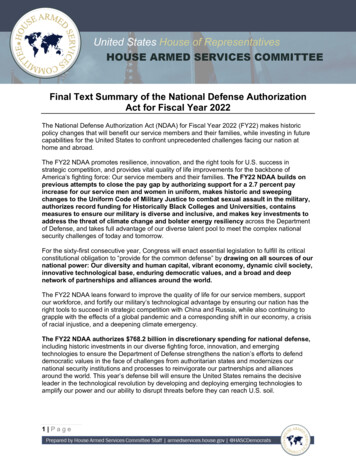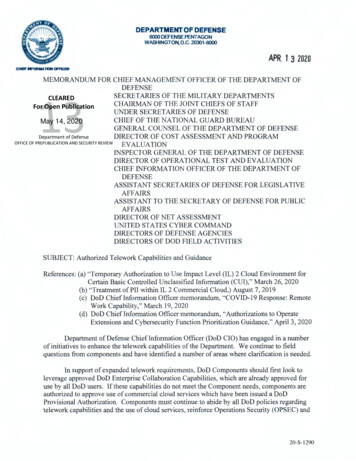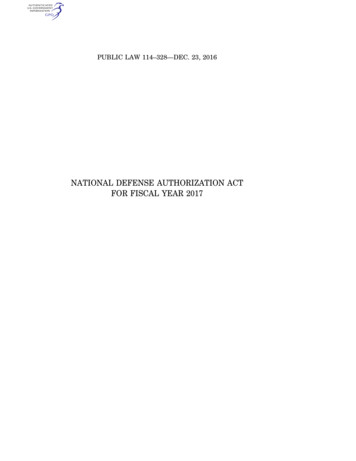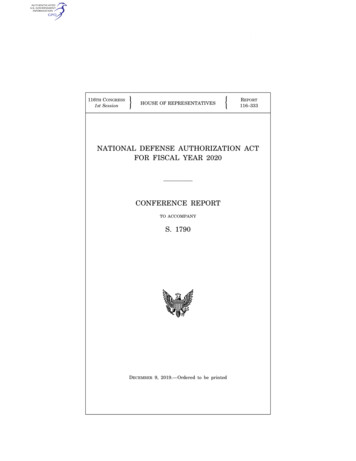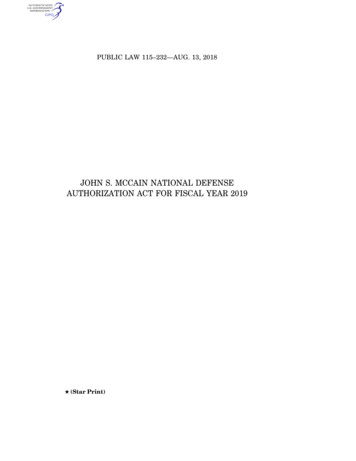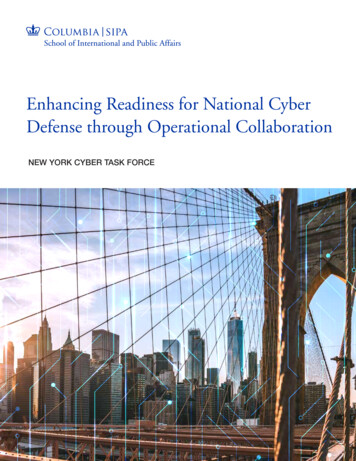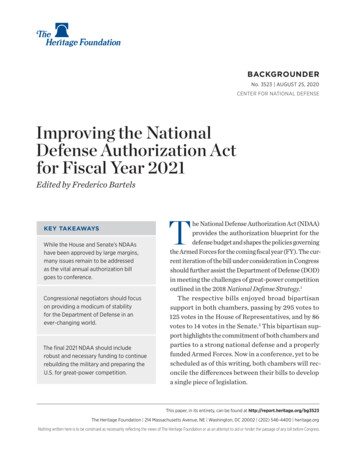
Transcription
BACKGROUNDERNo. 3523 August 25, 2020CENTER FOR NATIONAL DEFENSEImproving the NationalDefense Authorization Actfor Fiscal Year 2021Edited by Frederico BartelsKEY TAKEAWAYSWhile the House and Senate’s NDAAshave been approved by large margins,many issues remain to be addressedas the vital annual authorization billgoes to conference.Congressional negotiators should focuson providing a modicum of stabilityfor the Department of Defense in anever-changing world.The final 2021 NDAA should includerobust and necessary funding to continuerebuilding the military and preparing theU.S. for great-power competition.The National Defense Authorization Act (NDAA)provides the authorization blueprint for thedefense budget and shapes the policies governingthe Armed Forces for the coming fiscal year (FY). The current iteration of the bill under consideration in Congressshould further assist the Department of Defense (DOD)in meeting the challenges of great-power competitionoutlined in the 2018 National Defense Strategy.1The respective bills enjoyed broad bipartisansupport in both chambers, passing by 295 votes to125 votes in the House of Representatives, and by 86votes to 14 votes in the Senate.2 This bipartisan support highlights the commitment of both chambers andparties to a strong national defense and a properlyfunded Armed Forces. Now in a conference, yet to bescheduled as of this writing, both chambers will reconcile the differences between their bills to developa single piece of legislation.This paper, in its entirety, can be found at http://report.heritage.org/bg3523The Heritage Foundation 214 Massachusetts Avenue, NE Washington, DC 20002 (202) 546-4400 heritage.orgNothing written here is to be construed as necessarily reflecting the views of The Heritage Foundation or as an attempt to aid or hinder the passage of any bill before Congress.
BACKGROUNDER No. 3523heritage.org August 25, 2020 2The two chambers are fairly close to each other on the main issues, andon the surface, Congress appears able to approve the NDAA before the endof the fiscal year on September 30.3 Plenty of issues remain to be addressed,and this Backgrounder provides policy prescriptions designed to achievethe strongest possible U.S. national defense within the allocated resourcesto help the DOD prepare for great-power competition.The Military ServicesThe Army. In order to improve the Army sections of the NDAA, theconference should:llllllNot augment unrequired Army programs. In the current flat-budget environment, Congress should allocate funds to programsrequested by the Administration, either in the President’s budgetrequest or in the Service’s unfunded requirements lists, rather thanaugmenting unrequested programs. Both versions of the NDAA authorize money for systems the Army did not ask to procure: CH-47F BlockII aircraft and MQ-1 medium-altitude unmanned aerial vehicles.Drop the requirement for the Army to produce a plan on“interim cruise missile defense capability” that is currently inthe Senate version of the bill. The bill requires the Army to producea plan to deploy and station “interim cruise missile defense capability,”namely the two Iron Dome systems, which the 2019 NDAA requiredthe Army to procure.4 The Army has yet to even receive the systemsfor evaluation, nor is the Army certain of their ability to integrate theIron Dome systems into the Army’s larger Integrated Air and MissileDefense (IAMD) architecture.5 While cruise missile defense is ahigh-priority capability gap, requiring the Army to produce a plan todeploy and station systems that they have not evaluated is inappropriate at this time.Authorize a Regular Army end strength of 485,900. The President’s Budget Request asked for authority to increase the RegularArmy from 480,000 to 485,900. The Senate authorized an end strengthof 485,000, while the House authorized the full 485,900. The Army isalready far short of the size its leaders have said is necessary to executethe National Defense Strategy.6
BACKGROUNDER No. 3523heritage.org August 25, 2020 3ContributorsThomas W. Spoehr is Director of the Center for National Defense, of the Kathryn and Shelby Cullom Davis Instituteor National Security and Foreign Policy, at The Heritage Foundation.James Di Pane is Research Associate in the Center for National Defense.Patty-Jane Geller is Policy Analyst for Nuclear Deterrence and Missile Defense in the Center for National Defense.Brent D. Sadler is Senior Research Fellow for Naval Warfare and Advanced Technology in the Center forNational Defense.John Venable is Senior Research Fellow for Defense Policy in the Center for National Defense.Dakota L. Wood is Senior Research Fellow for Defense Programs in the Center for National Defense.Walter Lohman is Director of the Asian Studies Center, of the Davis Institute.Alexis Mrachek is Research Associate in the Douglas and Sarah Allison Center for Foreign Policy, of theDavis Institute.Ana Rosa Quintana is Senior Policy Analyst for Latin America and the Western Hemisphere in the Allison Center.Daniel Kochis is Senior Policy Analyst in European Affairs in the Margaret Thatcher Center for Freedom, of theDavis Institute.llDrop the House’s provision to remove the DC National Guard fromPresidential authority. The House version of the NDAA included aprovision allowing the mayor of the District of Columbia to preventthe deployment of the District’s National Guard under the authority ofthe President. This would prevent the President from employing theDC National Guard to protect federal property within the District or tosupport federal law enforcement activities. The DC National Guard istypically placed by the President under the control of the Secretary ofthe Army, an arrangement that has worked well in the past.The Navy. In order to improve the Navy sections of the NDAA, the conference should:llNot overburden unmanned Naval prototyping. While it is understandable that both chambers of Congress require certification of
BACKGROUNDER No. 3523heritage.org August 25, 2020 4reliability before procuring unmanned surface vessels, it is likewiseimportant that Congress encourage the effective and rapid prototyping needed to field such capabilities that will figure significantly inany future conflict. Overly burdensome reporting requirements andcertifications will hamper the process and risk delaying such crucialcapabilities for the future fleet.llllllFund long-lead-time parts for Naval shipbuilding. While theimmediate implications may be minor, not funding long-lead-timeparts for future construction of amphibious ships (the LHA-9, LPD32, and LPD-33) and Arleigh Burke-class destroyers is not withoutrisk. The House should reconsider and match the funding included inthe Senate version— 500 million for long-lead-time material for theLPD-32 and LPD-33; 260 million for Arleigh Burke-class destroyermaterials; and 250 million above request to accelerate constructionof the LHA-9. Not funding the long lead times could slow down theconstruction of urgently need ships.Support additional ship purchases to ensure meeting the 2034target of a 355-ship Navy. The House added additional monies, 2.1billion over the President’s request, to purchase a second Virginia-classsubmarine and an additional expeditionary fast transport (EPF), for atotal of nine new ships in FY 2021, which is two more than the Navy’scurrent request, and one less than under the 30-year ship-buildingplan.7 The addition of one submarine is in line with the Navy’s unfundedpriorities list, and addresses a critical capability needed by the combatant commands, such as the Indo–Pacific Command (INDOPACOM).8On the other hand, the Senate includes monies for long-lead-timeconstruction parts while conforming to the Navy request to purchaseseven new ships. Support for these additional ship purchases should beconditioned on the Navy’s ability to support delivery, and that increasedVirginia-class submarine construction not delay delivery of the first-inclass Columbia ballistic missile submarine.Support the increase in critical long-range munitions. TheSenate authorized increased production of critical long-range munitions for which INDOPACOM has argued strongly. The House shouldreconsider funding growth in these critical munitions, including theLong-Range Anti-Ship Missile (LRASM) and Tactical Tomahawk(TACTOM) Block V.
BACKGROUNDER No. 3523heritage.org August 25, 2020 5The Marine Corps. In order to improve the Marine Corps sections ofthe NDAA, the conference should:llllSupport the modernization of the U.S. Marine Corps (USMC).In general, both the Senate and House Armed Services Committeesfully support USMC efforts to modernize the Service and to beginshifting its focus to new challenges in the Indo–Pacific region. USMCfunding requests for continued improvement of legacy systems, suchas the amphibious assault vehicle and light armored vehicle, acquisition of the amphibious combat vehicle, and purchase of a range ofweapons that include anti-air, anti-armor, and anti-ship missiles arefully funded.9 The House went so far as to provide money for items onthe USMC’s unfunded priorities list to purchase additional groundbased anti-ship missiles, increasing funding by 59.65 million, or34 percent.10Advance the development of anti-ship missiles. Both chambersof Congress included monies ( 59.6 million) to support the MarineCorps in developing anti-ship missiles. This support has the potentialof enhancing the U.S. Naval presence, especially in the Western Pacific,where it can complicate Chinese and Russian military activities.The Air Force. In order to improve the Air Force sections of the NDAA,the conference should:llCommit to an accelerated acquisition program to expand the AirForce to no fewer than 386 operational squadrons as rapidly aspossible. The Air Force should acquire the most modern and fieldableweapons systems available, to include 100 F-35 aircraft in FY 2021.11In spite of a 30 percent increase in its budget over the past four years,the Air Force has not developed or executed a plan to accelerate theacquisition of aircraft to meet that requirement. Air Force proposalsto retire viable combat and combat-support platforms like the A-10,B-1, KC-10, and KC-135 serve the purpose of diminishing the AirForce’s capabilities before their replacements are available. Thosedivestments should end until the platforms in the current inventory,coupled with new acquisitions, bring the number of fighter, bomber,and air-refueling squadrons to the totals called for by “The AirForce We Need.”12
BACKGROUNDER No. 3523heritage.orgllllll August 25, 2020 6Terminate the acquisition of fourth-generation F-15EX fightersand accelerate the acquisition of fifth-generation F-35A fighters.The Air Force should acquire the most technologically advanced, cost-effective platforms available to ensure that its capability well exceeds peercompetitor forces, since both the Russian and Chinese air forces arenumerically superior to the U.S. Air Force. The Air Force’s current plan toacquire 140 F-15EX fighters will deliver markedly less capability, reducethe Air Force’s deployable combat capability, and cost the governmentmore to operate than buying 183 F-35As using the same level of funding.13Direct the Air Force to bring its primary combat-aircraft platforms up to an 80 percent mission capable (MC) rate by the endof 2021. In 2018, the Secretary of Defense directed the Air Force toincrease the MC rates of its F-16, F-22, and F-35 aircraft to 80 percentby the end of September 2019.14 MC rates measure how much of acertain fleet is “ready to go” at a given time, and the Secretary’s direction was to maximize the readiness of an all-too-small fleet of combataircraft that could deter or defeat a peer adversary. In early 2019, theAir Force Chief of Staff stated that the Service would not meet the 80percent MC threshold directive until 2020 and, in May 2020, he madeit clear that the 80 percent threshold was no longer a focus for the AirForce.15 Instead of using that historic marker for a peer-fight level ofreadiness, the Service is choosing to highlight how deployable “leadforce elements” within its fleet are within a short period of time.16While important in responding to a regional disturbance, the abilityto rapidly deploy small packages of combat aircraft is not an effectivemeasure of a Service’s ability to meet and defeat a peer competitor.That marker is, and has always been, MC rates—and in 2019, theaverage MC rates for the three fighters that the Secretary of Defensehad directed to reach 80 percent were at an abysmal 66 percent, and 67percent for the fighter fleet as whole.Fund and direct the Air Force to increase training flying hoursand sortie rates to a minimum of 17 hours a month and threesorties a week by the end of FY 2021. Fighter pilot combat capability is generally measured in the number of flying hours and sorties thatits operational fighter pilots receive, and both markers fell between2018 and 2019. The training time the average combat-mission-readypilot received fell from 16.1 hours and 8.3 sorties a month in 2018 tojust 14.6 hours and 7.4 sorties a month in 2019.17
BACKGROUNDER No. 3523heritage.org August 25, 2020 7Other National Defense CapabilitiesNuclear Enterprise. In order to improve the nuclear sections of theNDAA, the conference should:llllllMaintain strong support for nuclear modernization. Both theSenate and House versions of the NDAA fully fund the President’sbudget request for nuclear modernization programs within the DODand the National Nuclear Security Administration (NNSA). The DOD’sstrategic delivery platforms like the Minuteman III intercontinental-range ballistic missile and AGM-86B air-launched cruise missileare years past their intended lifetimes, leaving the acquisition of theirreplacement programs with little room for delay.18 Similarly, the NNSArequires a funding increase this year as it continues to move forwardwith a number of programs that would rebuild the tottering nuclearenterprise, such as plutonium pit production, as well as key warheadreplacement programs.19 Fortunately, there is current broad agreement on nuclear modernization funding.Not prohibit nuclear testing. The House passed an amendment thatprohibits the use of funds to conduct, or prepare to conduct, a nucleartest. While the United States operates under a testing moratorium, itmaintains nuclear-test readiness should the need arise to conduct anuclear test. The House’s misguided prohibition would impinge on thenation’s ability to respond to an emergency requiring a nuclear test toensure the functionality of the aging nuclear arsenal. The final conference agreement should instead include a Senate provision that adds 10 million for test readiness activities.20 Today, U.S. test readiness isweak; the NNSA has reported the unlikelihood of its ability to evenmeet the 24-to-36-month test readiness requirement.21 The UnitedStates should be improving its nuclear testing capabilities, not furtherinhibiting them.Not elevate the chairmanship of the Nuclear Weapons Councilto the Secretary level. A House amendment would establish the Secretaries of Defense and Energy as co-chairs of the Nuclear WeaponsCouncil, which is currently chaired by the Undersecretary of Defensefor Acquisition of Sustainment and the NNSA Administrator. TheNuclear Weapons Council plays the critical role of endorsing militaryrequirements for NNSA warhead activities, and currently functions
BACKGROUNDER No. 3523heritage.org August 25, 2020 8effectively.22 Governance of the nuclear enterprise has challenges, butleadership of the Nuclear Weapons Council is not one of them. TheHouse change would put the Secretary of Energy in a position to vetodecisions that relate exclusively to DOD capabilities. As the customerof the NNSA, the DOD should maintain its sole leadership of the council. Advocates of this provision argue that moving this decision-makingauthority to the Secretary level will elevate the importance of nuclearweapons, an idea that in reality runs contrary to the time-provenprinciple of divesting authority down the chain of command—in thiscase to the Undersecretary of Defense for Acquisition of Sustainment,who has the expertise and time to give nuclear weapons the attentionthey deserve.Weapons of Mass Destruction (WMDs). In order to improve theNDAA’s sections on WMDs, the conference should:llSupport the reporting requirements on a myriad of challengeswith WMDs. Both the House and the Senate Armed Services Committees appropriately took notice in the NDAA and its report languageof the current challenges presented by WMDs. The committees havewisely requested briefings, plans, and reports from the DOD on existing and emerging WMD threats, the DOD’s current WMD-relateddefense programs, and its preparedness for addressing WMD contingencies. In light of Syria’s use of chemical weapons, concerns aboutRussia’s compliance with the Chemical Weapons Convention; China’s,Iran’s, and North Korea’s nuclear programs; and the coronaviruspandemic, among other issues, these congressional oversight effortsare justified and should be supported in the NDAA conference.Missile Defense. In order to improve the missile defense sections ofthe NDAA, the conference should:llSupport the development of a tracking layer for the missiledefense architecture. Both the House and Senate agree on theimportance of accelerating the Hypersonic and Ballistic TrackingSpace Sensor (HBTSS), a program that will enable birth-to-deathtracking of all missiles from a proliferated constellation of satellitesin low-Earth orbit.23 The Administration has failed to request adequate funding for this program, placing it on the Missile DefenseAgency’s (MDA) Unfunded Priorities list in FY 2019 and FY 2020, and
BACKGROUNDER No. 3523heritage.org August 25, 2020 9requesting only 99.6 million for the program in FY 2021, a decreasefrom last year’s appropriation.24 The Senate and House bills correctthis budget issue with provisions that express the need to acceleratethis program and the addition of 120 million to the MDA to continuedeveloping the HBTSS.25llMaintain close oversight over the development of the homeland missile defense architecture. The House and Senate billsalso include critical oversight of the Administration’s plan for futurehomeland missile defense. After the cancellation of the RedesignedKill Vehicle in 2019 that would have replaced aging kill vehicles onthe ground-based interceptors (GBIs) that defend the homeland, theDOD initiated the Next Generation Interceptor (NGI) program tobe fielded not before the late 2020s. Recognizing that the advancingNorth Korean missile threat will begin to converge with increasingGBI obsolescence issues before then, House sections 1657 and 1658require reports, assessments, and certifications on both improvingthe performance of the existing GBIs and ensuring success of the NGIprogram. The Senate and House bills also both require the DOD toanswer critical questions on its plan to use regional systems to developa layered homeland missile defense.26 An underlay to the currentmissile defense infrastructure is a worthwhile pursuit, but could bea costly and time-consuming endeavor that Congress is correct tooversee closely.27Cyber Challenges. In order to improve the NDAA’s sections addressingthe nation’s cyber challenges, the conference should:llCreate a Senate-confirmed National Cyber Director. Appointinga Senate-confirmed National Cyber Director as recommended by theCybersecurity Solarium Commission would help with the coordination of national cybersecurity. This position, based on the model of theU.S. Trade Representative, would serve as the President’s chief cyberadvisor and coordinate cyber policy and budget requests throughoutthe government.28 This would enhance cyber policy by providingbetter coordination and unity of effort. Currently, the responsibilityfor protecting the cyber domain is spread broadly across a number ofdepartments and agencies throughout the government, and budgetrequests for cyber programs are not always coordinated.
BACKGROUNDER No. 3523heritage.orgllll August 25, 2020 10Conduct a force structure assessment of U.S. Cyber Command.The 133 teams of the Cyber Mission Force for U.S. Cyber Commandwere originally created and sized in 2013 to meet the needs of sevenyears ago. Since then, the world has changed and election security hasbeen added as a core mission for U.S. Cyber Command. General PaulNakasone, the Cyber Command Commander, recently acknowledgedthat his forces are not large enough for this expanded mission set.29Conducting a force structure assessment to determine the appropriateforce size would help to secure the U.S. in cyberspace by ensuring thatthe military has the right amount of personnel to conduct vital offensive and defensive missions.30 Once the appropriate size is determined,Congress should work with the executive branch to modify the forceaccordingly.Strengthen the Cybersecurity and Infrastructure Agency (CISA).Strengthening the CISA within the Department of Homeland Securitywould bolster its ability to support government agencies and workwith the private sector. Creating a Cyber Threat Information Collaboration Environment and an Integrated Cyber Center within theCISA would help it to better coordinate cybersecurity activity, sharethreat intelligence, and extend its support to private-sector partners.31 Threat intelligence is currently not distributed to the privatesector, which could be due to over-classification. Increasing the flowof information on threats to private-sector partners would help themto defend themselves from the threats they face. The CISA is uniquelyplaced to support both the private sector and government, and thesereforms would strengthen its ability to do so.Internal Pentagon Management. In order to improve the NDAA’ssections on internal Pentagon management, the conference should:llNot Terminate the Chief Management Officer (CMO). Both versionsof the NDAA terminate the CMO at the DOD, after a mere two and halfyears of existence.32 The position was created in the NDAA for FY 2017and has been active since February 1, 2018.33 The CMO simply has nothad enough time to effect any real change in how the Pentagon performsits business functions. It was only in 2020 that the CMO was empoweredto be actively involved in the budgeting process of the Pentagon entitiesoutside the Services.34 The CMO has only recently been able to establishthe office and settle the authorities around it; terminating the position
BACKGROUNDER No. 3523heritage.org August 25, 2020 11now would send the DOD tumbling down in the reform-learning curve.More time is needed to judge the efficacy of this position.35llKeep the provision that advances defense budget transparency.The Senate version of the NDAA includes an amendment that requeststhe federal government to “develop a methodologically sound set ofassumptions to underpin a comparison of the defense spending of thePeople’s Republic of China, the Russian Federation, and the UnitedStates.”36 That is an important initiative that will help both the UnitedStates and its allies to better understand and evaluate the defenseprograms of competitors.37 It will also further the understanding ofcompetitors’ military expenditures and development of methodologies to address the current knowledge gaps in estimates.AlliancesU.S. Posture in the Indo–Pacific Region. In order to improvethe NDAA’s sections on the U.S. posture in the Indo–Pacific, the conference should:llllSupport the creation of an Indo–Pacific Deterrence Initiative.There are a number of important provisions in both the House andSenate bills that signal the continuing U.S. commitment to the Indo–Pacific region and regional allies. Most prominent by far are thoseprovisions that are related to the proposed Pacific Deterrence Initiative. Both chambers have independent versions of the initiative, basedon initial inputs of the regional combatant command, to better allocate the defense resources necessary to meet regional commitments.38Both versions of the initiative emphasize logistics and improving thephysical assets in the region that will enable the United States to workmore closely with allies in the region. The initiative highlights theimportance of the region and of capabilities that improve the positionin the region.Maintain the prohibition on withdrawal of U.S. forces from theKorean Peninsula. The House bill wisely continues the prohibitionon the withdrawal of U.S. forces from the Korean Peninsula until sixmonths after the Secretary of Defense has certified that such a moveis in the security interest of the U.S., the reduction is commensuratewith the threat, South Korea can continue to deter an attack from the
BACKGROUNDER No. 3523heritage.org August 25, 2020 12North, and its allies have been consulted. The conference should adoptthe House language.llDemonstrate support for Taiwan. Both bills and the accompanyingreports contain multiple statements of support for Taiwan. Both billsreiterate U.S. adherence to the Taiwan Relations Act and PresidentRonald Reagan’s Six Assurances, and highlight the importance ofmilitary-to-military interaction with Taiwan. Both bills also voicesupport for port calls to Taiwan by U.S. Navy medical ships. RegardingChina, the bills are replete with reporting requirements designed togive Congress the information it needs to do its job and to let the DODknow what is most useful in that endeavor.U.S. Posture in Europe. In order to improve the NDAA’s sections onthe U.S. posture in Europe, the conference should:llllReverse the plans for force reductions in Europe. In July, the DODdetailed a decision to withdraw nearly 12,000 troops from Germany,with 5,600 repositioned elsewhere in Europe and 6,400 returning to theU.S.39 Returning these troops to the U.S. sends an unfortunate messagethat the U.S. is disengaging from security on the European continent.The decision saddles the U.S. with the significant cost of closing bases inGermany, establishing new facilities in Belgium, Italy, and the U.S., andmaintaining regular rotational forces from across the Atlantic, all thewhile reducing U.S. policymakers’ options for responding to contingencies in Europe, the Middle East, and North Africa.40Block funding for the removal of U.S. troops from Europe. Closing bases and removing U.S. troops from Europe will not be cheapwhen considering the cost of building new infrastructure in the U.S.for any returning units and the up-front cost of closing down facilitiesin Europe, and the significant financial cost of maintaining rotationaldeployments from the U.S., alongside the negative impact that suchdeployments can have on troop morale. Any decision to reduce thenumber of troops in Europe must be a strategic assessment about theneed of forward-deployed forces in Europe and the threats that couldemerge if they are withdrawn.41 Congress should understand andreview the decision to remove an additional 5,600 troops from Germany to bases in Belgium and Italy.
BACKGROUNDER No. 3523heritage.orgllllllll August 25, 2020 13Push back against pipelines that undermine security in Europe.The Nord Stream II (NSII) natural gas pipeline would connectGermany with Russia. It is neither economically necessary nor geopolitically prudent. NSII would, however, greatly increase Europeandependence on Russian gas, magnify Russia’s ability to use its European energy dominance as a political trump card, and specificallyundermine U.S. allies in Eastern and Central Europe.Keep up the pressure through sanctions. Current U.S. sanctionshave contributed to slowing down construction of the pipeline, andCongress should keep up the pressure. Preventing NSII from beingcompleted must remain a U.S. priority. NSII is a political project,opposed by the majority of U.S. allies in Europe, which would greatlyundermine transatlantic security. Congress should do all in its powerto ensure that the remaining sections of pipeline are never completed.While NSII may receive significant attention, the Turkish Streampipelines similarly seek to further entrench Russia’s position asEurope’s key energy supplier while choking off revenues that EasternEuropean countries collect via overland transit fees.Show support for Ukraine. Sections 1232 and 1235 of both versionsof the bill express essential support for Ukraine.42 For more than sixyears now, the war has raged on in Ukraine’s eastern Donbas regionwith no end in sight, and Crimea remains annexed by Russia.43 TheUnited States must not waver in its support for Ukraine.Push back against Russian “borderization” in Georgia. Boththe Senate and House should reaffirm the sense of Congress thatthe United States will maintain its support for Georgia’s territorialintegrity and sovereignty. Russia continues its unlawful processof “borderization” today in Georgia’s regions of Abkhazia and SouthOssetia.44 Georgia is an important partner of the United States, and theNDAA should include support of Georgia.U.S. Interests in the Western Hemisphere. In order to improve theNDAA’s sections on U.S. interests in the Western Hemisphere, the conference should:llRemove two amendments that undermine U.S. interests inColombia and regional stability. The House NDAA contains
BACKGROUNDER No. 3523heritage.org August 25, 2020 14two restrictive amendments on DOD activities in Colombia.45 Oneamendment prohibits U.S. funding for aerial fumigation to eradicateColombia’s coca crops, and the other would alter ongoing counternarcotics operations that the United States supports. These amendmentsundermine U.S. interests and would set back Colombia’s hard-foughtsecurity and stability achievements. The amendments would alsocontribute to Latin America’s drug trafficking crisis and increase U.S.cocaine overdose rates.46 The U.S. and Colombi
l Support the modernization of the U.S. Marine Corps (USMC). In general, both the Senate and House Armed Services Committees fully support USMC efforts to modernize the Service and to begin




